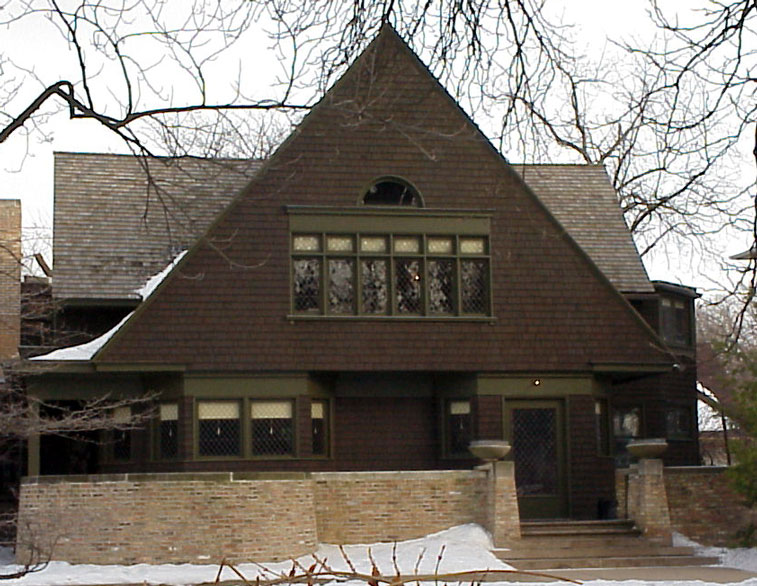The separation between public and private spaces became less defined in the beginning of the 20th century with the work of Frank Lloyd Wright and the modern movement. Frank Lloyd Wright searched for his own style as well as an American style in his work which reflects the arts and crafts style. Wright worked under Louis Sullivan and took much of his inspiration from the work he did with Sullivan and his firm. Wright came into his own however and developed a very recognizable style of his own that went far beyond the original 'Chicago-school' style of architecture. Wrights work was inspired by nature and integrated the outdoors into the interior through large windows and stone and natural materials. Through this outdoor/indoor design, Wright chose not to follow traditional home designs where living areas are specifically designed. His floor plans such as those at Falling Water have no defining walls, simply a few load bearing walls and columns (Massey 84).
Design is a visual language. It can tell a story and evoke feelings without words as art does. Two similar examples which were designed to evoke very strong emotions in the people who walked through the spaces are the Holocaust Memorial in Berlin and The Holocaust Museum in the United States. The Holocaust Museum in the US exhibits dark feelings of fear and gives the viewer the experience of being in the holocaust itself. Small doorways, sharp angles, and the use of concrete tell the viewer how cold and hard life must have been like living in the camps of the Holocaust. The use of concrete and many sharp rectangular prisms of all different sizes describes the Holocaust Memorial in Berlin. It is a "Memorial to the Murdered Jews of Europe" designed by Peter Eisenman. The space is very abstract and one experiences the space through it's design language. Personally I see the many blocks as representing the coffins of each individual affected by the Holocaust. It is difficult to navigate freely through the space since the blocks are presented in grid form. Some choose to walk on top of the blocks while others weave throughout the rows. The blocks are thick and heavy which represent the weight of the deaths on the German people and all those involved (http://www.holocaust-mahnmal.de/en).
Architectural techniques are passed down to each generation. Techniques that have consistently been followed throughout time are those first developed in classical Greece and Rome. Columns and decoration inspired by classical designs some of the most popular techniques in architecture alone. Arrangement of spaces has even translated from ancient times into modern architecture. The Baths of Caracalla and their arrangement of large public space inspired Pennsylvania Station in NYC by McKim, Mead, & White (Roth 505). Spanish architect Antoni Gaudi developed his famous style through inspiration from techniques of the Moors such as the 'molded forms based on curved structural walls' (Roth 511).
 An early image of UNCG's Quad. Are these buildings bringing the campus historic character or simply using too much energy and not providing enough housing for our growing campus.
An early image of UNCG's Quad. Are these buildings bringing the campus historic character or simply using too much energy and not providing enough housing for our growing campus.Virtual renderings can be very helpful because they are detailed and precise. Although many argue that they lack character and that is why students must learn different drawing techniques. The comparison between virtual and hand-crafted harkens back to the argument between handmade and machine-made designs. One finds character in hand-made and historic designs. A local issue right here at UNCG is whether or not we should demolish the historic 1920's dormatories in the quad. There is a great need for more student housing and these dorms are using more energy and space then they need to be. Demolishing these buildings would be unsustainable and would take away the architectural character these buildings bring to the university. The dorms in the quad remind the students that UNCG is a historic school. UNCG started as a school for women and now sororities mainly live in the quad, making the quad a historic home for women students. The other issue is that the dorms are not sustainable as they are and UNCG needs more dorms. Building a new dorm in a new area means cutting down trees and interfering with the environment as well, so each option will be unsustainable, we really must find the lesser of the evils.
 Virtual renderings such as the one above show a great amount of detail, yet I think that hand drawn renderings provide much more character and a designer is able to express their concept through stylistic techniques rather than computer animation that is the same for every rendering.
Virtual renderings such as the one above show a great amount of detail, yet I think that hand drawn renderings provide much more character and a designer is able to express their concept through stylistic techniques rather than computer animation that is the same for every rendering. Craft and techniques help to create a space that is narrated through a specific design language. The 20th century gave way to the development of space planning and modernism. Whithin the latter sphere of the 20th century and the beginning of the 21st we saw design become a virtual experience. Many argue that these virtual techniques, although precise, are not as personable as handcrafted renderings are. Just as handcrafted is often preferred by many, so are older buildings compared to brand new buildings. As designers we struggle between following the past and creating new forms for the future and how we build these forms can be just as important.




No comments:
Post a Comment